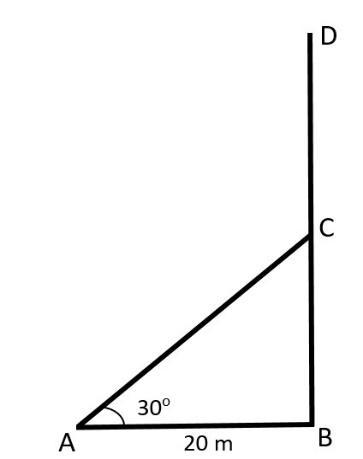
The upper part of a tree, broken by wind in two parts, makes an angle of ${{30}^{\circ }}$ with the ground. The top of the tree touches the ground at a distance of 20 metres from the foot of the tree. Find the height of the tree before it is broken.
Answer
605.4k+ views
Hint: Here when the tree is broken, a triangle is formed and using the triangle we can find the height of the tree.
Complete step-by-step answer:
First with the given data we have to draw the figure.

In this figure BD is the tree, due to wind it is broken from the point C where $CD=CA$. The broken tree makes an angle of ${{30}^{\circ }}$ with the ground. i.e. $\angle BAC={{30}^{\circ }}$
Here, the distance between the top of the tree that touches the ground and foot of the tree is 20 m. i.e. $AB=20\text{ m}$.
Here, we have to calculate the height of the tree, i.e. $BD$.
From the figure, we can say that,
$\begin{align}
& BD=BC+CD \\
& BD=BC+CA \\
\end{align}$
For that, first consider $\vartriangle ABC$, the tangent of A is given by,
$\begin{align}
& \tan {{30}^{\circ }}=\dfrac{oposite\text{ }side}{adjacent\text{ }side} \\
& \tan {{30}^{\circ }}=\dfrac{BC}{AB} \\
& \tan {{30}^{\circ }}=\dfrac{BC}{20}\text{ }....\text{ (1)} \\
\end{align}$
We know that $\tan {{30}^{\circ }}=\dfrac{1}{\sqrt{3}}$, by substituting this value in equation (1) we get:
$\dfrac{1}{\sqrt{3}}=\dfrac{BC}{20}$
By cross multiplication we get,
$\begin{align}
& 20=\sqrt{3}BC \\
& BC=\dfrac{20}{\sqrt{3}} \\
\end{align}$
To find $CA$, consider the cosine of A, we obtain:
$\begin{align}
& \cos {{30}^{\circ }}=\dfrac{\text{adjacent }side}{hypotenuse} \\
& \cos {{30}^{\circ }}=\dfrac{AB}{CA} \\
& \cos {{30}^{\circ }}=\dfrac{20}{CA}\text{ }.....\text{ (2)} \\
\end{align}$
We also know that $\cos {{30}^{\circ }}=\dfrac{\sqrt{3}}{2}$ our equation (2) becomes:
$\dfrac{\sqrt{3}}{2}=\dfrac{20}{CA}$
By cross multiplication we get,
$\begin{align}
& \sqrt{3}CA=2\times 20 \\
& \sqrt{3}CA=40 \\
& CA=\dfrac{40}{\sqrt{3}} \\
\end{align}$
Next, we have to calculate $BD$ where.
$\begin{align}
& BD=BC+CA \\
& BD=\dfrac{20}{\sqrt{3}}+\dfrac{40}{\sqrt{3}} \\
\end{align}$
By taking the LCM we get:
$\begin{align}
& BD=\dfrac{20+40}{\sqrt{3}} \\
& BD=\dfrac{60}{\sqrt{3}} \\
& BD=\dfrac{60}{1.73}\text{ }....\text{(}\sqrt{3}=1.73) \\
& BD=34.682 \\
\end{align}$
Hence, we obtain the height of the tree is $34.682$.
Note: Here, you may get confused regarding the tree and the broken part of the tree, from the figure we can say that CA is the broken part of the tree and CA=CD.
Complete step-by-step answer:
First with the given data we have to draw the figure.

In this figure BD is the tree, due to wind it is broken from the point C where $CD=CA$. The broken tree makes an angle of ${{30}^{\circ }}$ with the ground. i.e. $\angle BAC={{30}^{\circ }}$
Here, the distance between the top of the tree that touches the ground and foot of the tree is 20 m. i.e. $AB=20\text{ m}$.
Here, we have to calculate the height of the tree, i.e. $BD$.
From the figure, we can say that,
$\begin{align}
& BD=BC+CD \\
& BD=BC+CA \\
\end{align}$
For that, first consider $\vartriangle ABC$, the tangent of A is given by,
$\begin{align}
& \tan {{30}^{\circ }}=\dfrac{oposite\text{ }side}{adjacent\text{ }side} \\
& \tan {{30}^{\circ }}=\dfrac{BC}{AB} \\
& \tan {{30}^{\circ }}=\dfrac{BC}{20}\text{ }....\text{ (1)} \\
\end{align}$
We know that $\tan {{30}^{\circ }}=\dfrac{1}{\sqrt{3}}$, by substituting this value in equation (1) we get:
$\dfrac{1}{\sqrt{3}}=\dfrac{BC}{20}$
By cross multiplication we get,
$\begin{align}
& 20=\sqrt{3}BC \\
& BC=\dfrac{20}{\sqrt{3}} \\
\end{align}$
To find $CA$, consider the cosine of A, we obtain:
$\begin{align}
& \cos {{30}^{\circ }}=\dfrac{\text{adjacent }side}{hypotenuse} \\
& \cos {{30}^{\circ }}=\dfrac{AB}{CA} \\
& \cos {{30}^{\circ }}=\dfrac{20}{CA}\text{ }.....\text{ (2)} \\
\end{align}$
We also know that $\cos {{30}^{\circ }}=\dfrac{\sqrt{3}}{2}$ our equation (2) becomes:
$\dfrac{\sqrt{3}}{2}=\dfrac{20}{CA}$
By cross multiplication we get,
$\begin{align}
& \sqrt{3}CA=2\times 20 \\
& \sqrt{3}CA=40 \\
& CA=\dfrac{40}{\sqrt{3}} \\
\end{align}$
Next, we have to calculate $BD$ where.
$\begin{align}
& BD=BC+CA \\
& BD=\dfrac{20}{\sqrt{3}}+\dfrac{40}{\sqrt{3}} \\
\end{align}$
By taking the LCM we get:
$\begin{align}
& BD=\dfrac{20+40}{\sqrt{3}} \\
& BD=\dfrac{60}{\sqrt{3}} \\
& BD=\dfrac{60}{1.73}\text{ }....\text{(}\sqrt{3}=1.73) \\
& BD=34.682 \\
\end{align}$
Hence, we obtain the height of the tree is $34.682$.
Note: Here, you may get confused regarding the tree and the broken part of the tree, from the figure we can say that CA is the broken part of the tree and CA=CD.
Recently Updated Pages
Two men on either side of the cliff 90m height observe class 10 maths CBSE

What happens to glucose which enters nephron along class 10 biology CBSE

Cutting of the Chinese melon means A The business and class 10 social science CBSE

Write a dialogue with at least ten utterances between class 10 english CBSE

Show an aquatic food chain using the following organisms class 10 biology CBSE

A circle is inscribed in an equilateral triangle and class 10 maths CBSE

Trending doubts
Why is there a time difference of about 5 hours between class 10 social science CBSE

Write a letter to the principal requesting him to grant class 10 english CBSE

What is the median of the first 10 natural numbers class 10 maths CBSE

The Equation xxx + 2 is Satisfied when x is Equal to Class 10 Maths

Which of the following does not have a fundamental class 10 physics CBSE

State and prove converse of BPT Basic Proportionality class 10 maths CBSE




